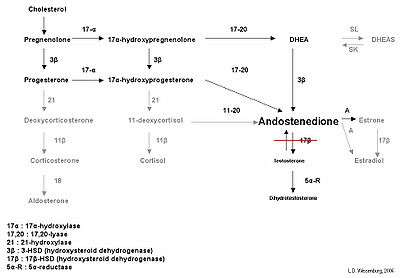17-beta-hydroxysteroid dehydrogenase deficiency
| 17β-Hydroxysteroid dehydrogenase deficiency | |
|---|---|
| Classification and external resources | |
| OMIM | 264300 |
| DiseasesDB | 32638 |
17β-Hydroxysteroid dehydrogenase III deficiency is a rare disorder of sexual development affecting testosterone biosynthesis by 17β-hydroxysteroid dehydrogenase III (17β-HSD III), which can produce impaired virilization (traditionally termed male pseudohermaphroditism) of genetically male infants and children and excessive virilization of female adults.
It is an autosomal recessive[1] condition and is one of the few disorders of sexual development that can affect the primary and/or secondary sex characteristics of both males and females.
Prevalence
In the Netherlands, 17β-hydroxysteroid dehydrogenase III deficiency is estimated to occur in 1:147,000 newborns.[2]
Clinical characteristics
17-β-Hydroxysteroid dehydrogenase III deficiency is clinically characterized by either ambiguous external genitalia or complete female external genitalia at birth; as a consequence of impaired male sexual differentiation in 46,XY individuals. Further investigations on ambiguous genitalia will eventually lead to findings of intersexuality. Severely impaired virilization (often complete absence of male sexual differentiation) can lead to development of female external genitalia. These children are raised as female, and their diagnosis is often discovered when there is absence of menarche (first menstruation) and when they begin to virilize during puberty (slowly become more like a man; deepening of the voice, acne, male musculature etc.). At careful examination, testis can often be found in the inguinal channel.
Biochemistry

17β-Hydroxysteroid dehydrogenase III deficiency is characterized biochemically by decreased levels of testosterone and increased levels of androstenedione as a result of the defect in conversion of androstenedione into testosterone. This leads to clinically important higher ratio of androstenedione to testosterone (A'dion/T) (see figure).
Genetics

17β-Hydroxysteroid dehydrogenase III deficiency is caused by mutations found in the 17β-HSD III (17BHSD3) gene.[3] 17β-HSD III deficiency is an autosomal recessive disorder.
See also
- Inborn errors of steroid metabolism
- Disorders of sexual development
- Intersexuality, pseudohermaphroditism and ambiguous genitalia
- 17β-Hydroxysteroid dehydrogenase (III)
- Sex hormone (androgen and estrogen)
References
- ↑ Andersson, S; Geissler, Wm; Wu, L; Davis, Dl; Grumbach, Mm; New, Mi; Schwarz, Hp; Blethen, Sl; Mendonca, Bb; Bloise, W; Witchel, Sf; Cutler, Gb Jr.; Griffin, Je; Wilson, Jd; Russel, Dw (January 1996). "Molecular genetics and pathophysiology of 17 beta-hydroxysteroid dehydrogenase 3 deficiency". The Journal of Clinical Endocrinology and Metabolism. 81 (1): 130–6. doi:10.1210/jc.81.1.130. ISSN 0021-972X. PMID 8550739.
- ↑ Boehmer, A. L. M. (1999). "17 -Hydroxysteroid Dehydrogenase-3 Deficiency: Diagnosis, Phenotypic Variability, Population Genetics, and Worldwide Distribution of Ancient and de Novo Mutations". Journal of Clinical Endocrinology & Metabolism. 84 (12): 4713–21. doi:10.1210/jc.84.12.4713. PMID 10599740.
- ↑ Lindqvist, A; Hughes, Ia; Andersson, S (February 2001). "Substitution mutation C268Y causes 17 beta-hydroxysteroid dehydrogenase 3 deficiency" (Free full text). The Journal of Clinical Endocrinology and Metabolism. 86 (2): 921–3. doi:10.1210/jc.86.2.921. ISSN 0021-972X. PMID 11158067.